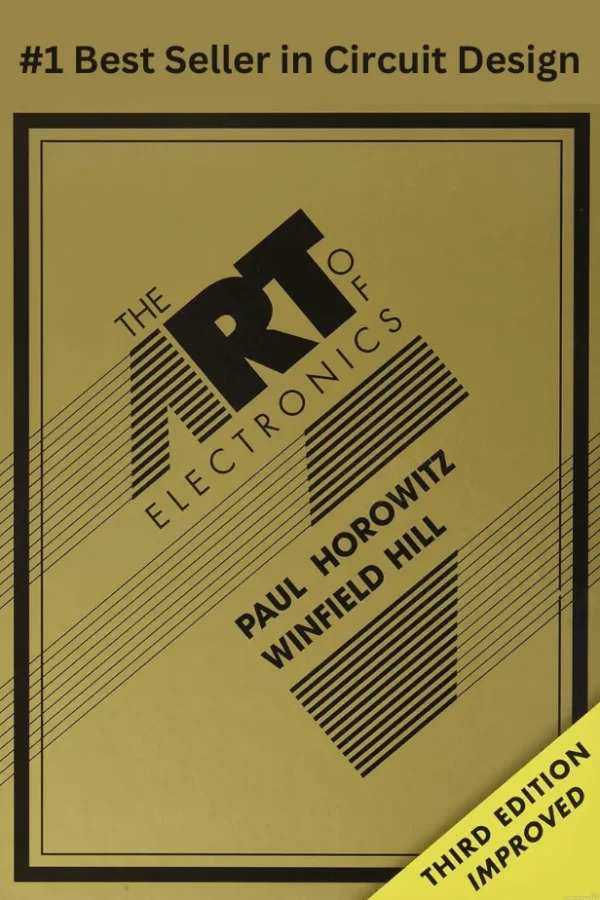Download The Art of Electronics 3rd Edition PDF.
Finally, the thoroughly revised and updated third edition of the hugely successful The Art of Electronics is here. It is widely accepted as the single authoritative book on electronic circuit design. In addition to new or enhanced coverage of many topics, the third edition includes 90 oscilloscope screenshots illustrating the behavior of working circuits, dozens of graphs giving highly useful measured data of the sort that is often buried or omitted in datasheets but which you need when designing circuits, and 80 tables (listing some 1650 active components), enabling intelligent choice of circuit components by listing essential characteristics (both specified and measured) of available parts. The new Art of Electronics retains the feeling of informality and simple access that helped make the earlier editions so successful and popular. It is an indispensable reference and the gold standard for anyone who works with electronic circuits.

Editorial Reviews
Review
Limor ‘Ladyada' Fried, Adafruit Industries.“First of all, after I forwarded [Chapter 5] onto my reading table, I sat down and read it. It is simply spectacular. That may be overly exclamatory language, but it is the only appropriate verbiage I can summon. Spectacular, deep, and wide.” I particularly like the comments about interpreting specifications, and the deconstruction of the Agilent voltmeters is just fantastic.”
Jim Williams, Linear Technology Corp.
“Wow. Chapter 5 describes every circuit artifact that I've encountered over the past thirty years. My only ‘twinge' is that [it] disclosed and explained (in glorious graphical detail and with real part numbers) many topics that I thought were my trade secrets. I love the plots. I know that compiling device characteristics must be overwhelming. It's worth the effort. The way it presents the data allows the reader to get a terrific perspective on a lot of landscapes from a single point of view. Nice work.”
John Willison, founder of Stanford Research Systems.
“Horowitz and Hill's third edition beautifully upgrades their earlier work, with substantial updates to detail and without compromise to style, content, or technical quality. Like the second edition I've used for years, it is laser-focused on the working engineer. Delivered in folksy Horowitz and Hill style, it is rich with the kind of nitty-gritty information that's invaluable to circuit designers and manufacturers, much of which is absent (or difficult to find) elsewhere. This new book is a superb update, one which I'm sure will be treasured by those close to the art of analog circuitry.”
Walt Jung, author of the IC Op-Amp Cookbook.
“This epic work was created by two of the best experts in the field, with many others providing information. It describes the current state of the art in electronics. Most parts of the book will continue to be relevant for several decades. The 1124 pages (even more densely packed with highly accurate information than the pages of the second edition) will delight everyone who already knows about electronics. You'll probably like the third edition better than the second. We recommend getting the book immediately because it has great information in both quality and quantity.”
Wise Warthog blog.
“If you are looking for a handy and very practical electronics reference book, this is a decent one. I think you will enjoy it. Thanks to Horowitz and Hill for updating this classic.”
Lou Frenzel, Electronic Design (electronicdesign.com).
“If you are a hobbyist or maker who wants to acquire or improve a well-rounded knowledge of electronics, then The Art of Electronics is the perfect book for you.” It starts with the very basics of voltage, current, and resistance without becoming heavily dependent on physics theory or mathematics, and then covers a huge variety of intriguing topics. This book helps electronic engineering students develop an intuitive understanding, which makes math easier to put in context and is invaluable for design project work. The Art of Electronics brilliantly conveys its authors' enthusiasm and practical engineering experience, making it an inspiring read. Many people have described the earlier editions as the best book on electronics, so [this third edition] had a lot to live up to; fortunately, it does not disappoint. It deserves its gold cover.”
Ian Bell, Everyday Practical Economics.
‘I believe the strength of this book stems from the authors’ background in physics. The key is that electronics are not their primary interest. This ‘application perspective’ is most evident in their presentation: the material is presented to understand the behavior of electronic devices, circuits, and systems before the nitty-gritty details of calculating the behavior. The authors are also liberal in their use of commercially available parts in their presentation, something rarely, if ever, seen in a typical textbook. There is an abundance of warning, based on real-world experience, of the many traps that lie in wait for the practitioner of electronic art. Despite the analog bent, the digital information in this book is an excellent source for the analog engineer to get started using digital systems for the control of analog circuits. All in all, it's a highly recommended addition to the working engineer’s bookshelf.'
Book Description
About the Author
Paul Horowitz is Professor of Physics at Harvard University, where he originated the Laboratory Electronics course in 1974, from which emerged The Art of Electronics. He was a pioneer in the search for intelligent life beyond Earth, as well as one of the leaders behind SETI. Other research interests include observational astrophysics, x-ray and particle microscopy, and optical interferometry. He has authored some 200 scientific articles and reports, consulted extensively for industry and government, and designed numerous electronic and photographic instruments.
Winfield Hill has held positions at numerous organizations, including Harvard University's Electronic Design Center and Sea Data Corporation. Currently, he is the Director of Electronics Engineering at the Rowland Institute for Science, where he has designed some 250 electronic instruments. Recent interests include high-voltage RF (to 15 kV) and precision high-current electronics (to 6000 A).

![A Hands-On Course in Sensors Using the Arduino and Raspberry Pi (Series in Sensors) [1 ed] A Hands-On Course in Sensors Using the Arduino and Raspberry Pi (Series in Sensors) [1 ed]](https://lededitpro.com/wp-content/uploads/2024/08/A-Hands-On-Course-in-Sensors-Using-the-Arduino-and-Raspberry-Pi-Series-in-Sensors-1-ed-300x450.webp)



Reviews
There are no reviews yet.